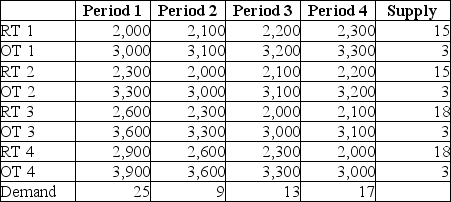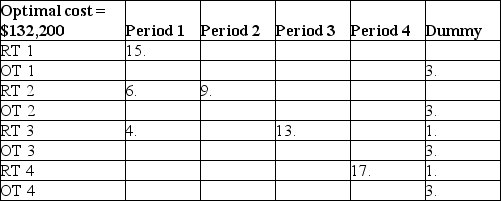Essay
Reddick's Specialty Electronics makes weatherproof surveillance systems for parking lots. Demand estimates for the next four quarters are 25, 9, 13, and 17 units. The firm is preparing an aggregate plan that uses inventory, regular time and overtime and back orders. Subcontracting is not allowed. Regular time capacity is 15 units for quarters 1 and 2, 18 units for quarters 3 and 4. Overtime capacity is 3 units per quarter. Regular time cost is $2000 per unit, while overtime cost is $3000 per unit. Back order cost is $300 per unit per quarter; inventory holding cost is $100 per unit per quarter. Beginning inventory is zero.
The data inputs for this problem, and the optimal solution, generated by microcomputer software, appear below. Answer the following questions based on the scenario and the solution.
(a) How many total units will be produced in quarter 1 for delivery in quarter 1?
(b) How many units in total will be used to fill back orders over the four quarters?
(c) What is the cost to produce one unit in Quarter 4 using overtime to deliver in quarter 1 (filling a back order)?
(d) At the end of quarter 3, what is the ending inventory of finished systems?
(e) What is the total cost of the solution?
(f) What is the average cost per unit?
Reddick's Specialty Electronics
 Reddick's Specialty Electronics Solution
Reddick's Specialty Electronics Solution

Correct Answer:

Verified
a. 15; b. 10; c. $3,...View Answer
Unlock this answer now
Get Access to more Verified Answers free of charge
Correct Answer:
Verified
View Answer
Unlock this answer now
Get Access to more Verified Answers free of charge
Q102: A large consulting firm is deciding if
Q103: Disaggregation is the process of breaking the
Q104: Which of the following is NOT an
Q105: What four things are needed to develop
Q106: Which choice below best describes the counterseasonal
Q108: When developing an aggregate plan, one of
Q109: _ involves capacity decisions that determine the
Q110: In level scheduling, what is kept uniform
Q111: _ are designed to be consistent with
Q112: One of the capacity options of aggregate